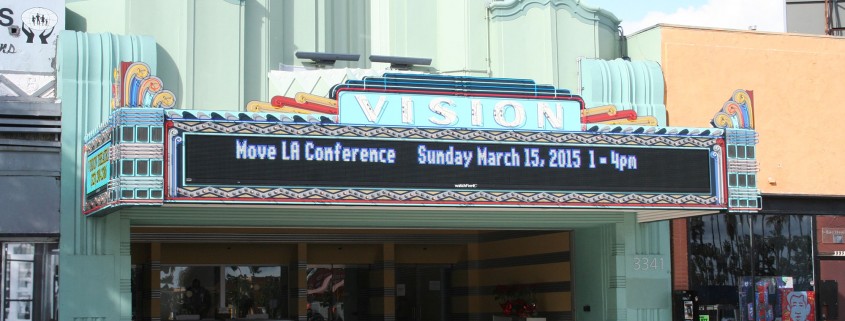Leimert Park overflows with community and culture
Leimert Park began and ended differently than all of my other column adventures thus far. Usually, I have a specific place or event to write about, somewhere I’ve been before or extensively heard about.
This week was slightly different. There was no specific place or event I wanted to feature, just a general area I’d never explored: the Leimert Park neighborhood just south of Exposition Boulevard. Like most Trojans, I’m frequently drawn north of campus by the towering Downtown skyline, but I rarely venture south of campus without a plan. This week, I decided to explore the south the same way I do Downtown — by wandering around until something cool happens.
In the 1920s, Leimert Park was created as a planned community, complete with the orderly, tree-lined streets and matching rows of Spanish-style homes. We drove past these well-kept old homes, soul food restaurants, and small mom-and-pop stores before arriving in the historic Leimert Plaza Park.
Today, Leimert Park is recognized as a central hub for African-American arts and culture in Los Angeles. The Leimert Plaza Park is supported by a growing list of organizations, including the office of Los Angeles Mayor Eric Garcetti, the Kwanzaa Heritage Foundation and USC’s own Annenberg Innovation Lab.
The park itself is how I first heard about the neighborhood; its Yelp page is filled with glowing reviews that describe chess tournaments, drum circles and markets. When we arrived at the park, however, it was nearly empty, probably due to the gloomy weather forecast.
So we wandered, Anthony Bourdain, No Reservations-style. Leimert Plaza Park borders the historic Vision Theater and unique storefronts. As we walked through stores, two things immediately stood out: the community’s sense of civic responsibility, and the people’s appreciation for the arts — which often blend together.
In Leimert Park, civic action and the arts collide. A large mural features the quote, “The good of the village outweighs the good of the individual.” An art gallery displays a sticker reading, “No day in a person’s life should pass without an act of charity.” Telephone poles are equally covered with flyers encouraging residents to vote and announcing free performing arts classes.
Storeowners sell their wares bazaar-style, resulting in an open atmosphere. There’s Jamaican food, homemade tribal masks and a healing center. Relaxed and friendly, community members often sit outside chatting.
The neighborhood seems like it should be infiltrated by hipsters and new businesses, but it isn’t. Instead, Leimert Park has remained completely authentic. Unlike many historic parts of Los Angeles, the cultural sites of Leimert Park aren’t mixed in with trendy restaurants and chain businesses. Leimert Plaza Park is purely Leimert Plaza Park.
“This feels like it would be a tourist stop, but there’s no tourists,” commented one of my friends.
Just as we were about to leave, a community member rushed out of his store. “Are you writing an article about us?” he asked. Tentatively, I answered yes. “Come back tomorrow, that’s when the art walk is,” he explained. He eagerly pointed to a hidden jazz venue, before launching into a list of other events the neighborhood offers.
So the next day, we returned to the now-crowded park. There was drumming, DJs and dancing. More of a block party than a farmer’s market, the event served as a microcosm of the neighborhood’s familial atmosphere. This meant that we stood out as non-residents, as if we were strangers from a block over. But, residents are friendly and quick to pitch their goods.
We sampled homemade shea butter, and I was talked into buying a cardinal and gold bracelet by a friendly seller. The community’s sense of civic action even echoes through their wares, with shirts touting the well-known phrase, “black lives matter.”
Residents share a sense of passion for their cause, for their products and for each other. Within just a two-mile radius of campus, the neighborhood itself is small, but it boasts large community pride. The area even hosts its own news site, the Leimert Park Beat, which lists upcoming events.
I learned about the art walk by simply walking down the street, and the more time I spent in the neighborhood, the more unique activities I heard about. I’ll return soon on a Thursday, when Project Blowed presents its weekly, famously long-running hip-hop show. And with jazz performances, theater shows and performing arts classes, the event list goes on and on. I entered Leimert Park with a vague story idea, but left with a long arts and culture to-do list.
Erin Rode is a freshman majoring in environmental engineering and print and digital journalism. Her column, “The Rode Less Traveled,” runs Thursdays.


One of these days I will definitely call my cousin out in L.A. and check him, and go see Leimert Park for myself. Patronize the local businesses, and vibe with the people and the street scene I will definitely do that.
I love stories like these. I love seeing a black community thrive. Leimert Park village is bustling with African-American cultural events and thriving and vibrant black owned businesses.Chinese got Chinatown, Japanese got Japantown, Vietnamese got Little Saigon, Italians got Little Italy, and Mexicans got mexicantown, but we got Leimert Park Village. Our blacktown. Right there in L.A. Tom Bradley lived there, Jon Singleton lives there now. And he ain’t gonna live in a rat hole. That’s why the Spanish style homes are so damn nice cause its kept up by a large concentration of successful black owned businesses. And blacks are patronizing those businesses. Cause otherwise the place would be a damn shit house. Cause if you fail to circulate your dollars in your own community, you got no right to complain about nothing. You got no one to blame but yourself. Simple as that.